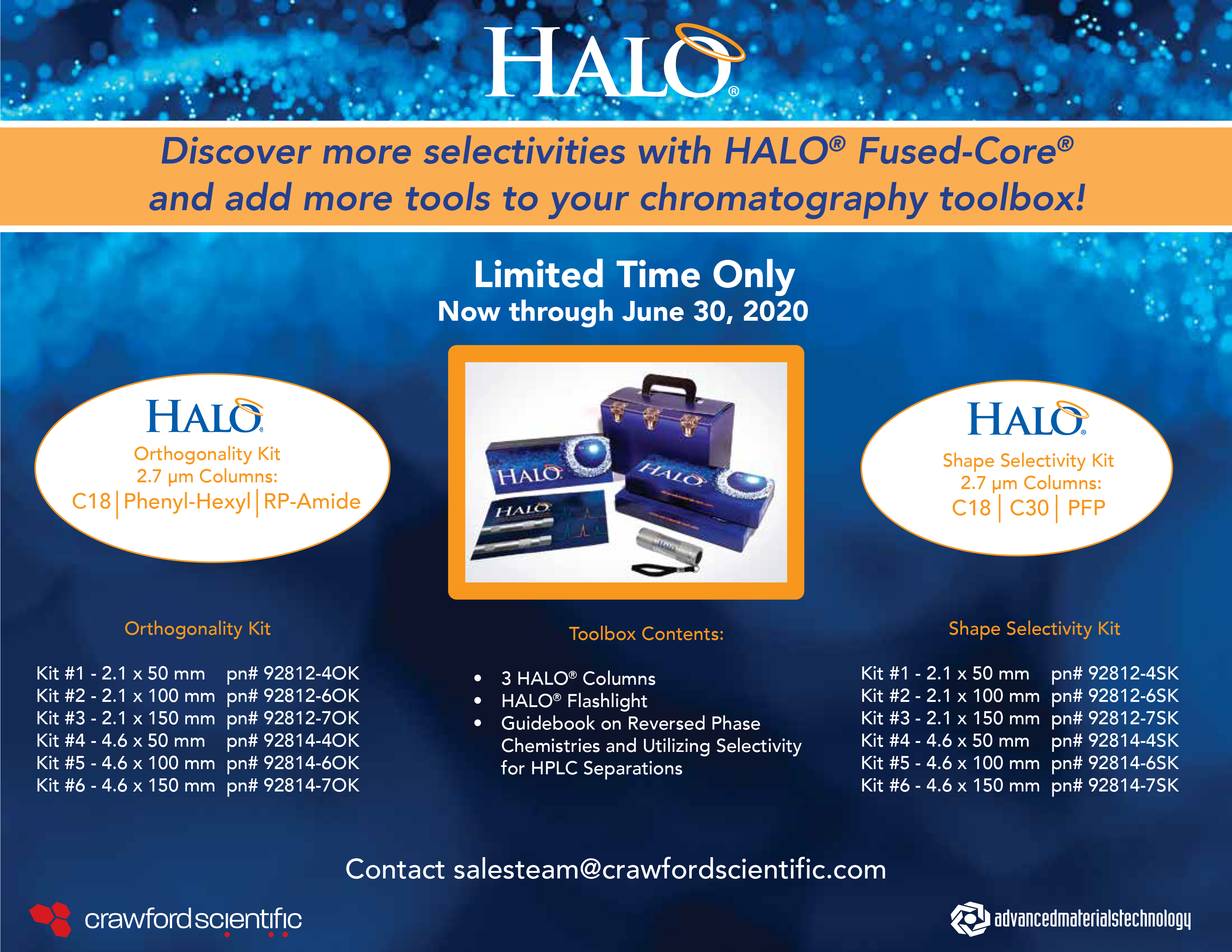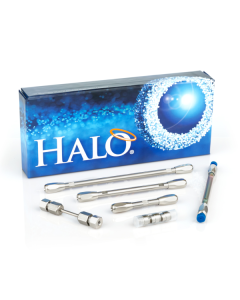

Say goodbye to tailing peaks with the new product line of HALO® PCS (Positively Charged Surface) HPLC columns, now available from Advanced Materials Technology.
If you're a chromatographer who’s ever struggled with poor peak shapes for basic compounds, you're not alone. Standard C18 and Phenyl-Hexyl phases often leave us with tailing peaks, unpredictable retention, and limited loading capacity – especially when running LCMS methods using low ionic strength mobile phases such as 0.1% formic acid.
The HALO® PCS series of columns are a game changing family of HPLC columns with a positively charged surface, specifically engineered to tackle the challenges of basic analytes and peptides, without compromising your method compatibility or speed.
All HALO® PCS columns are built upon proven Fused-Core® particle technology, ensuring high efficiency, fast separations, and low backpressure. Whether you're working with small molecules or complex peptides, HALO® PCS brings the performance you expect – along with the added benefit of a charged surface that significantly improves the separation of basic compounds.
Why You Need a Positively Charged Surface
Basic compounds are notoriously difficult in reversed phase HPLC, especially under acidic conditions preferred for LCMS. The challenge lies in tailing peaks, limited sample load capacity, and inefficient separations resulting from undesirable interactions between basic analytes and the stationary phase. HALO® PCS solves this by introducing a positively charged ligand to the surface of the silica particles. Under acidic conditions, the basic analytes also become positively charged – repelling them from the stationary phase, reducing unwanted interactions, and significantly improving peak shape and reproducibility. Peak shape of acids and neutrals will be unaffected by the PCS C18 phase, making it a great tool for multi-component samples.
Key Features & Benefits of HALO® PCS Technology
- Sharper, symmetrical peaks for basic compounds – even at higher sample loads
- Suitable for LC-MS and UHPLC – Designed to perform effectively with low ionic strength mobile phases, including 0.1% formic acid
- Maintains excellent performance for acids and neutrals
- Available in multiple pore sizes (90 Å for small molecules, 160 Å for peptides)
- Alternative selectivity to traditional C18 and Phenyl-Hexyl phases
HALO® PCS Specifications
HALO® PCS columns are available with 2.7 µm particle sizes – 2 µm particle sizes will be launched in September 2025! Each column phase has 2.1 mm, 3.0 mm and 4.6 mm ID options, as well as 1.5 mm ID, which delivers increased sensitivity and reduced solvent consumption. Guard columns for each phase are also available, to increase column’s lifetime while preserving efficiency.
| HALO® PCS C18 | HALO® PCS Phenyl Hexyl | HALO® BioClass PCS C18 | |
| Phase Type | Positively charged C18 | Positively charged phenyl hexyl | Positively charged C18 |
| Ligand | Dimethyloctadecylsilane | 6-phenylhexyldimethylsilane | Dimethyloctadecylsilane |
| USP Designation | L1 | L11 | L1 |
| Particle Size | 2.7 µm | 2.7 µm | 2.7 µm |
| Pore Size | 90 Å | 90 Å | 160 Å |
| Low pH Limit | 2 | 2 | 2 |
| High pH Limit* | 7 | 7 | 7 |
| Temperature Limit at Low pH | 60°C | 60°C | 60°C |
| Temperature Limit at High pH* | 40°C | 40°C | 40°C |
| Endcapped | Yes | Yes | Yes |
| Carbon Load | 7.4% | 6.1% | 5.0% |
| Surface Area | 125 m2/g | 125 m2/g | 90 m2/g |
| Pressure Limit | 600 bar | 600 bar | 600 bar |
| Guards Available | Yes | Yes | Yes |
| Applications | Basic pharmaceutical drugs, environmental contaminants, drugs of abuse | Basic pharmaceutical drugs, environmental contaminants, drugs of abuse | Peptide mapping & detection, impurity analysis |
*Column lifetime will vary depending on the operating temperature and the type and concentration of buffers used – operation at extreme specifications of temperature and pH may reduce column lifetime. Consult the Column Care and Use document for more information.
Comparative Analysis & Experimental Results
Separation Using HALO® PCS C18 Compared with Uncharged C18:
A mixture of four antidepressants was separated using the HALO 90 Å PCS C18 column with a 0.1% formic acid mobile phase. The results below (Figure 1) demonstrate that compared to a conventional uncharged C18 stationary phase, the HALO® PCS C18 delivered improved tailing factors and enhanced separation efficiency.


Figure 1: Analysis of antidepressants using HALO® PCS C18 compared to uncharged C18 stationary phase.
Competitor Comparison of Charged Surface Phases
In a direct comparison of charged surface solid core particle columns, the HALO® PCS C18 delivers superior resolution, improved tailing factors, and higher plate counts compared to the leading competitor (Figure 2):


Figure 2: Comparison of HALO® PCS C18 against leading competitor
Separation Using HALO® BioClass PCS C18 Compared to Traditional Uncharged C18 Peptide Column
The HALO® BioClass PCS C18 was used to screen a synthetic panel of basic peptides along with a solid core traditional C18 stationary phase. The results below (Figure 3) show that while using low ionic strength mobile phases such as formic acid, the positively charged surface stationary phase gives significantly narrower peak widths and improved symmetry for more basic peptides when compared to a traditional non-endcapped peptide C18 stationary phase.


Figure 3: Improved peak shape with the HALO® BioClass PCS C18 column compared to a traditional C18 column using a gradient with water/ ACN/0.1% formic acid
Stability & Reproducibility
A panel of antidepressants screened with 1,000 injections (10,000 column volumes) demonstrates the excellent stability of HALO® PCS C18 (Figure 4).
Lot to Lot comparison of PCS C18 columns clearly show the reproducibility and good peak shapes for basic, acidic and neutral compounds (Figure 5):


Figure 4: Stability analysis of HALO® PCS C18


Figure 5: Lot to Lot comparison of HALO® PCS C18
Conclusion
In summary, the positively charged HALO® PCS stationary phases offer analysts a versatile surface chemistry that enhances separations of basic compounds for both small molecules and peptides.
Select the appropriate phase and pore size to address the challenges of tailing peaks and inconsistent results with confidence and precision. For optimal performance, HALO® PCS columns should be operated under acidic conditions to take advantage of its positively charged surface. The PCS columns are particularly beneficial in mass spectrometry method development, as they support the use of formic acid – boosting ionisation efficiencies while maintaining good peak shape and also minimising instrument contamination. The combination of the high efficiency of the Fused-Core® particle and the functionality of the HALO® PCS phases makes them a valuable product for any chromatographer’s laboratory.
Resources
HALO® Technical Overview - White Paper
App Note - IMPROVED BIOSEPARATIONS WITH HALO® PCS C18 PEPTIDE
App Note - CURRENT LC/MS APPROACHES FOR PFAS ANALYSIS WITH ULTRASHORT AND LONG CHAIN MIXTURES
You can find the full range of Advanced Materials Technology HPLC Columns on our website.








